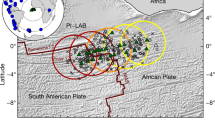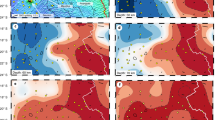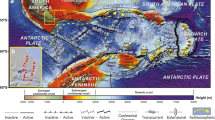Abstract
More than a third of mid-ocean ridges have a spreading rate of less than 20 millimetres a year1. The lack of deep imaging data means that factors controlling melting and mantle upwelling2,3, the depth to the lithosphere–asthenosphere boundary (LAB)4,5, crustal thickness6,7,8,9 and hydrothermal venting are not well understood for ultraslow-spreading ridges10,11. Modern electromagnetic data have greatly improved our understanding of fast-spreading ridges12,13, but have not been available for the ultraslow-spreading ridges. Here we present a detailed 120-kilometre-deep electromagnetic joint inversion model for the ultraslow-spreading Mohns Ridge, combining controlled source electromagnetic and magnetotelluric data. Inversion images show mantle upwelling focused along a narrow, oblique and strongly asymmetric zone coinciding with asymmetric surface uplift. Although the upwelling pattern shows several of the characteristics of a dynamic system3,12,13,14, it probably reflects passive upwelling controlled by slow and asymmetric plate movements instead. Upwelling asthenosphere and melt can be traced to the inferred depth of the Mohorovičić discontinuity and are enveloped by the resistivity (100 ohm metres) contour denoted the electrical LAB (eLAB). The eLAB may represent a rheological boundary defined by a minimum melt content. We also find that neither the melt-suppression model7 nor the inhibited-migration model15, which explain the correlation between spreading rate and crustal thickness6,16,17,18,19, can explain the thin crust below the ridge. A model in which crustal thickness is directly controlled by the melt-producing rock volumes created by the separating plates is more likely. Active melt emplacement into oceanic crust about three kilometres thick culminates in an inferred crustal magma chamber draped by fluid convection cells emanating at the Loki’s Castle hydrothermal black smoker field. Fluid convection extends for long lateral distances, exploiting high porosity at mid-crustal levels. The magnitude and long-lived nature of such plumbing systems could promote venting at ultraslow-spreading ridges.
This is a preview of subscription content, access via your institution
Access options
Access Nature and 54 other Nature Portfolio journals
Get Nature+, our best-value online-access subscription
$29.99 / 30 days
cancel any time
Subscribe to this journal
Receive 51 print issues and online access
$199.00 per year
only $3.90 per issue
Buy this article
- Purchase on Springer Link
- Instant access to full article PDF
Prices may be subject to local taxes which are calculated during checkout




Similar content being viewed by others
Code availability
MARE2DEM20 is a parallel adaptive finite element code for two-dimensional forward and inverse modelling for electromagnetic geophysics and was used for data modelling and inversion in this project. MARE2DEM is available for download at http://mare2dem.ucsd.edu/. The CSEM and MT processing software used in this study are available from EMGS ASA http://www.emgs.com/, but restrictions apply to the availability of the software, which were used under special agreement for the current study, and so they are not publicly available. The software is, however, available from the corresponding author upon reasonable request and with permission of EMGS ASA.
Data availability
The data that support the findings of this study are available from NTNU, but restrictions apply to the availability of these data, which were used under special agreement for the current study. All relevant data are, however, available from the corresponding author upon reasonable request and with the permission of NTNU.
References
Dick, H. J. B., Lin, J. & Schouten, H. An ultraslow-spreading class of ocean ridge. Nature 426, 405–412 (2003).
Evans, R. L. et al. Geophysical evidence from the MELT area for compositional controls on oceanic plates. Nature 437, 249–252 (2005).
Forsyth, D. W. & Chave, A. D. Experiment investigates magma in the mantle beneath mid-ocean ridges. Eos 75, 537–540 (1994).
Schlindwein, V. & Schmid, F. Mid-ocean-ridge seismicity reveals extreme types of ocean lithosphere. Nature 535, 276–279 (2016).
Stern, T. A. et al. A seismic reflection image for the base of a tectonic plate. Nature 518, 85–88 (2015).
Bown, J. W. & White, R. S. Variation with spreading rate of oceanic crustal thickness and geochemistry. Earth Planet. Sci. Lett. 121, 435–449 (1994).
Reid, I. & Jackson, H. R. Oceanic spreading rate and crustal thickness. Mar. Geophys. Res. 5, 165–172 (1981).
Zhou, H. & Dick, H. J. B. Thin crust as evidence for depleted mantle supporting the Marion Rise. Nature 494, 195–200 (2013).
Jokat, W. et al. Geophysical evidence for reduced melt production on the Arctic ultraslow Gakkel mid-ocean ridge. Nature 423, 962–965 (2003).
Edmonds, H. N. et al. Discovery of abundant hydrothermal venting on the ultraslow-spreading Gakkel ridge in the Arctic Ocean. Nature 421, 252–256 (2003).
Pedersen, R. B. et al. Discovery of a black smoker vent field and vent fauna at the Arctic Mid-Ocean Ridge. Nat. Commun. 1, 126 (2010).
Baba, K., Chave, A. D., Evans, R. L., Hirth, G. & Mackie, R. L. Mantle dynamics beneath the East Pacific Rise at 17 S: insights from the Mantle Electromagnetic and Tomography (MELT) experiment. J. Geophys. Res. Solid Earth 111, B02101 (2006).
Key, K., Constable, S., Liu, L. & Pommier, A. Electrical image of passive mantle upwelling beneath the northern East Pacific Rise. Nature 495, 499–502 (2013).
Wang, Y., Forsyth, D. W. & Savage, B. Convective upwelling in the mantle beneath the Gulf of California. Nature 462, 499–501 (2009).
Cannat, M. How thick is the magmatic crust at slow spreading oceanic ridges? J. Geophys. Res. Solid Earth 101, 2847–2857 (1996).
Michael, P. J. et al. Magmatic and amagmatic seafloor generation at the ultraslow-spreading Gakkel ridge, Arctic Ocean. Nature 423, 956–961 (2003).
Dick, H. J. B. & Zhou, H. Ocean rises are products of variable mantle composition, temperature and focused melting. Nat. Geosci. 8, 68–74 (2015).
Niu, Y. & Hékinian, R. Spreading-rate dependence of the extent of mantle melting beneath ocean ridges. Nature 385, 326–329 (1997).
Su, W., Mutter, C. Z., Mutter, J. C. & Buck, R. Some theoretical predictions on the relationships among spreading rate, mantle temperature, and crustal thickness. J. Geophys. Res. Solid Earth 99, 3215–3227 (1994).
Key, K. MARE2DEM: a 2-D inversion code for controlled-source electromagnetic and magnetotelluric data. Geophys. J. Int. 207, 571–588 (2016).
Ni, H., Keppler, H. & Behrens, H. Electrical conductivity of hydrous basaltic melts: implications for partial melting in the upper mantle. Contrib. Mineral. Petrol. 162, 637–650 (2011).
Constable, S. SEO3: a new model of olivine electrical conductivity. Geophys. J. Int. 166, 435–437 (2006).
McKenzie, D., Jackson, J. & Priestley, K. Thermal structure of oceanic and continental lithosphere. Earth Planet. Sci. Lett. 233, 337–349 (2005).
Conley, M. M. & Dunn, R. A. Seismic shear wave structure of the uppermost mantle beneath the Mohns Ridge. Geochem. Geophys. Geosyst. 12, Q0AK01 (2011).
Bruvoll, V., Breivik, A. J., Mjelde, R. & Pedersen, R. B. Burial of the Mohn-Knipovich seafloor spreading ridge by the Bear Island Fan: time constraints on tectonic evolution from seismic stratigraphy. Tectonics 28, TC4001 (2009).
Hermann, T. & Jokat, W. Crustal structures of the Boreas basin and the Knipovich Ridge, North Atlantic. Geophys. J. Int. 193, 1399–1414 (2013).
Ritzmann, O., Jokat, W., Mjelde, R. & Shimamura, H. Crustal structure between the Knipovich Ridge and the Van Mijenfjorden (Svalbard). Mar. Geophys. Res. 23, 379–401 (2002).
Hopper, J. R. et al. Tectonostratigraphic Atlas of the North-East Atlantic Region http://www.nagtec.org/ (Geological Survey of Denmark and Greenland, Copenhagen, 2014).
Baumberger, T. et al. Fluid composition of the sediment-influenced Loki’s Castle vent field at the ultra-slow spreading Arctic Mid-Ocean ridge. Geochim. Cosmochim. Acta 187, 156–178 (2016).
Spiegelman, M., McKenzie, D. J. E. & Letters, P. S. Simple 2-D models for melt extraction at mid-ocean ridges and island arcs. Earth Planet. Sci. Lett. 83, 137–152 (1987).
Sparks, D. W., Parmentier, E. J. E. & Letters, P. S. Melt extraction from the mantle beneath spreading centers. Earth Planet. Sci. Lett. 105, 368–377 (1991).
Gripp, A. E. & Gordon, R. G. Young tracks of hotspots and current plate velocities. Geophys. J. Int. 150, 321–361 (2002).
Turner, A. J., Katz, R. F., Behn, M. D. & Keller, T. Magmatic focusing to mid-ocean ridges: the role of grain-size variability and non-Newtonian viscosity. Geochem. Geophys. Geosyst. 18, 4342–4355 (2017).
Egbert, G. D. Robust multiple-station magnetotelluric data processing. Geophys. J. Int. 130, 475–496 (1997).
Constable, S. C., Parker, R. L. & Constable, C. G. Occam’s inversion: a practical algorithm for generating smooth models from electromagnetic sounding data. Geophysics 52, 289–300 (1987).
Mittet, R. & Morten, J. P. Detection and imaging sensitivity of the marine CSEM method. Geophysics 77, E411–E425 (2012).
Wannamaker, P. E., Hohmann, G. W. & Ward, S. H. Magnetotelluric responses of three-dimensional bodies in layered earths. Geophysics 49, 1517–1533 (1984).
Berdichevsky, M. N. & Dmitriev, V. I. Models and Methods of Magnetotellurics (Springer Science & Business Media, Berlin/Heidelberg, 2010).
Takahashi, E. & Kushiro, I. Melting of a dry peridotite at high pressures and basalt magma genesis. Am. Mineral. 68, 859–879 (1983).
Wyllie, P. J. Magma genesis, plate tectonics, and chemical differentiation of the Earth. Rev. Geophys. 26, 370–404 (1988).
Maaløe, S. The solidus of harzburgite to 3 GPa pressure: the compositions of primary abyssal tholeiite. Mineral. Petrol. 81, 1–17 (2004).
Sifré, D. et al. Electrical conductivity during incipient melting in the oceanic low-velocity zone. Nature 509, 81–85 (2014).
Acknowledgements
We thank the Faculty of Engineering, Department of Geoscience and Petroleum, NTNU Oceans, the ROSE consortium (with financial support from Norwegian Research Council, grant number 228400) and the Geophysics group at the Norwegian University of Science and Technology (NTNU) for funding the survey. We thank EMGS ASA for collecting excellent data in a very challenging environment.
Reviewer information
Nature thanks Steven Constable and Rob Evans for their contribution to the peer review of this work.
Author information
Authors and Affiliations
Contributions
S.E.J. developed the project, analysed the data and wrote the manuscript. H.E.F.A. analysed the data and wrote the manuscript together with S.E.J. Data were processed and the Methods section was prepared by M.P. and R.M. All authors took part in data analyses, discussed the results and commented on the manuscript.
Corresponding author
Ethics declarations
Competing interests
The authors declare no competing interests.
Additional information
Publisher’s note: Springer Nature remains neutral with regard to jurisdictional claims in published maps and institutional affiliations.
Extended data figures and tables
Extended Data Fig. 1 Bathymetry and electromagnetic acquisition geometry.
Water depth (black), receiver positions with names (yellow triangles) and the CSEM source track (red) for the acquired two-dimensional line at Loki’s Castle.
Extended Data Fig. 2 CSEM data examples.
Measured CSEM data (dots) and synthetic data for the resulting model from CSEM data inversion (lines) for two selected receivers at line positions (−3 km and +25 km). The electric-field magnitude (top) and phase data (bottom) are displayed for the frequencies 0.5 Hz (blue), 1.0 Hz (green) and 2.0 Hz (red). The total root-mean-square error for the resulting resistivity model is 1.13.
Extended Data Fig. 3 Inverted and measured MT data.
MT (transverse magnetic mode) data (circles) and synthetic data (solid lines) for the inversion result are shown for all MT stations used. The total root-mean-square misfit is 1.4. ρa is apparent resistivity.
Extended Data Fig. 4 Anisotropic resistivity model from two-dimensional CSEM data inversion.
Image of the horizontal resistivity ρh (top) and the vertical resistivity ρv (bottom). The resulting model has a root-mean-square misfit of 1.13. The locations of the electromagnetic receivers are shown as white circles.
Extended Data Fig. 5 Anisotropic resistivity model from simultaneous joint inversion of CSEM and MT (transverse magnetic mode) data.
The three components of the resistivity tensor—ρx, ρy and ρz—show strong similarities owing to strong anisotropy regularization. CSEM receiver positions are plotted as circles, and receivers with MT used in the joint inversion are plotted as triangles. The model fits the data with a root-mean-square misfit of 1.4.
Extended Data Fig. 6 Temperature, conductivity and melt content versus depth beneath the Mohns Ridge.
a, Temperature versus depth for the 3 Myr west profile. TMAX, calculated by inverting measured conductivities to TSEO3 (Fig. 3a), is shown as grey circles. The resulting geotherm (heavy black line) is consistent with adiabatic upwelling combined with a 3 Myr halfspace cooling model. Dry solidi for lherzolite39,40 and harzburgite41 are shown for reference. b, Temperature versus depth for the axial profile with adiabatic upwelling to the depth of the eMoho combined with a near-linear cooling trend towards 320 °C at the seabed (Loki’s Castle). TMAX, calculated by inverting measured conductivities to TSEO3 (Fig. 3a), is shown as orange circles. c, Temperature versus depth for the 4 Myr east profile. TMAX, calculated by inverting measured conductivities to TSEO3 (Fig. 3a), is shown as blue circles. The resulting geotherm (heavy black line) reflects adiabatic upwelling to eLAB depth combined with a gradual cooling towards 4 Myr halfspace model temperatures about 15 km below the seabed. d, Resistivity versus depth and calculated melt content42 for the 3 Myr west profile. Calculated resistivity versus depth for dry DMM (SEO3), basalt + 1 wt% H2O and gabbro are shown for reference. e, Resistivity versus depth and calculated melt content42 for the axial profile. Calculated resistivity versus depth profiles for dry DMM (SEO3), basalt + 1 wt% H2O and gabbro are shown for reference. f, Resistivity versus depth and calculated melt content42 for the 4 Myr east profile. Calculated resistivity versus depth profiles for dry DMM (SEO3), basalt + 1 wt% H2O and gabbro are shown for reference.
Rights and permissions
About this article
Cite this article
Johansen, S.E., Panzner, M., Mittet, R. et al. Deep electrical imaging of the ultraslow-spreading Mohns Ridge. Nature 567, 379–383 (2019). https://doi.org/10.1038/s41586-019-1010-0
Received:
Accepted:
Published:
Issue Date:
DOI: https://doi.org/10.1038/s41586-019-1010-0
This article is cited by
-
Sulfide metallogenic model for the ultraslow-spreading Southwest Indian Ridge
Science China Earth Sciences (2023)
-
Low-noise, low-power-consumption seafloor vector magnetometer
Journal of Oceanology and Limnology (2023)
-
Spreading-rate dependence of hydroacoustic and teleseismic seismicity of ridge-transform systems: East Pacific Rise, Galapagos Ridge, and Mid-Atlantic Ridge
Acta Oceanologica Sinica (2022)
-
Tectonic evolution and geodynamics of the Neo-Tethys Ocean
Science China Earth Sciences (2022)
-
Fluid-rich subducting topography generates anomalous forearc porosity
Nature (2021)
Comments
By submitting a comment you agree to abide by our Terms and Community Guidelines. If you find something abusive or that does not comply with our terms or guidelines please flag it as inappropriate.



